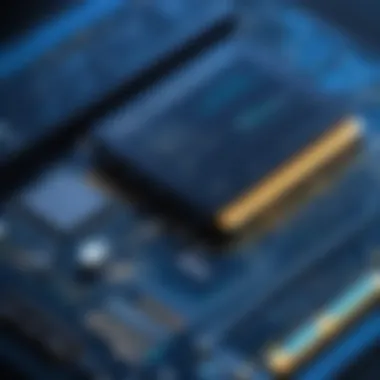Mastering Unix Device Management: An In-Depth Guide


Overview of Topic
Unix device management plays a central role in the functioning of Unix-based operating systems. At its core, it involves the coordination and control of various hardware components through established software interfaces. This section introduces the fundamental concepts of device management, clarifying its importance within the larger tech landscape that is continuously evolving.
The scope of this guide encompasses a detailed examination of the architecture of Unix device management, touching on how it integrates with essential components like device drivers, file systems, and system calls. Understanding these components is vital for optimizing system performance and ensuring reliability, which are crucial elements for both personal computing and enterprise environments.
Historically, Unix was developed in the late 1960s and early 1970s, significantly contributing to the evolution of computing. Over the decades, device management has evolved alongside advancements in technology, adapting to handle a diverse range of hardware from basic peripherals to sophisticated network devices.
Fundamentals Explained
To comprehend Unix device management fully, one must grasp several core principles. Device management essentially revolves around the interaction between software and hardware. The main functions include identifying devices, managing access to them, and facilitating communication.
Key terminology is essential to navigating this field:
- Device Driver: Software that interfaces with hardware.
- File System: A method for storing and organizing files.
- System Call: An interface between the application layer and the kernel.
A foundational understanding of these concepts is critical. Each of these components plays a specific role, ensuring that the operating system can effectively communicate with physical devices.
Practical Applications and Examples
In real-world applications, Unix device management proves essential. For instance, when connecting a printer, the relevant device driver must be identified and correctly loaded by the system. This allows user applications to send print jobs without needing to understand the underlying hardware.
One notable example is configuring a network interface. Users can enable or disable the interface through the command line while underlying device drivers manage the actual communication. This dual-layer approach illustrates the effectiveness of Unix's design.
Code snippets can significantly ease the practical learning process. Below is an example of a shell command to list all devices recognized by the system:
Advanced Topics and Latest Trends
The field of Unix device management is not static. Cutting-edge developments include improvements in the way device drivers are developed, often leaning towards a more modular architecture. This allows for updates without restarting the system, enhancing overall reliability.
Moreover, new methodologies are emerging, including the increasing use of virtualization. This trend allows multiple virtual devices to run on a single physical device, increasing efficiency and resource utilization.
Looking forward, the adaptability of Unix device management will be essential in handling upcoming technologies such as IoT devices. Future systems will demand even more sophisticated means of managing diverse and sometimes transient hardware.
Tips and Resources for Further Learning
For those eager to deepen their understanding of Unix device management, several resources can be valuable:
- Books: "Unix Device Drivers" by Bill Gryphon.
- Courses: Online courses from platforms like Coursera and Udemy focused on Unix/Linux system administration.
- Tools: Familiarity with tools like for managing device events can greatly enhance practical skills.
Furthermore, engaging with online communities such as those found on Reddit can provide additional insights and support.
Learning about Unix device management not only enhances theoretical understanding but also equips practitioners with the skills to optimize system performance and troubleshoot issues effectively.
Foreword to Unix Device Management
Device management in Unix systems plays a critical role in ensuring effective communication between hardware and software. It lays the foundation for system functionality by facilitating the interaction between various applications and the underlying hardware components. Understanding device management is essential for anyone operating within Unix environments, as it influences everything from performance optimization to resource allocation.
Understanding Devices in Unix
In a Unix context, devices can be understood as physical or virtual components that the operating system can manage. This includes hard drives, network cards, and peripheral devices, all of which are essential for system operation. Each device is represented by a file in the directory. The method in which these devices interact with the system is governed by device drivers, which are specialized software modules that enable the kernel to communicate with the hardware.
Devices in Unix are generally categorized into two types: block devices and character devices. Block devices handle data in blocks, meaning the operating system can read or write a block of data at a time. Examples include hard drives and USB drives. Character devices, in contrast, transmit data as a stream of characters, handling one character at a time. Examples of character devices are keyboards and mice.
Importance of Device Management
Device management is pivotal for several reasons. Firstly, it enhances system stability and performance. Efficient device management ensures that hardware resources are allocated properly, which leads to better overall system efficiency. When devices are managed well, the risk of resource conflicts is minimized, leading to decreased likelihood of system crashes.
Secondly, understanding device management aids in troubleshooting. When issues arise, knowing how devices are configured and controlled can quickly lead to their resolution. This knowledge proves beneficial for IT professionals and students learning programming languages, as it cultivates skills necessary for effective system administration.
Finally, good device management practices contribute to the security of the Unix system. By knowing which devices are connected and how they interact with the system, administrators can better protect against unauthorized access and potential vulnerabilities. Thus, mastering device management is not only useful but essential for anyone aiming to wield deeper command over the Unix operating system.
"Effective device management is crucial for optimizing Unix system performance and reliability."
Architecture of Unix Device Management
Understanding the architecture of Unix device management is essential because it establishes a foundation for how devices are controlled and utilized within the system. This architecture consists of multiple layers that facilitate communication between user applications and hardware devices. By grasping the layout and function of these layers, users can enhance performance and troubleshoot issues more effectively. The architecture integrates device drivers, kernel space, and user space, leading to optimized resource handling and device responsiveness.
The Unix operating system employs a clear separation between the kernel space and user space. This distinction is vital for both stability and security. The kernel handles core functionalities, including device management, whereas the user space runs applications and services. This division minimizes the chances of a faulty application compromising system integrity. Furthermore, it allows for efficient memory management and process control.
Kernel and User Space
In Unix, kernel space is where the operating system core functions reside. It holds essential system resources and manages tasks such as memory allocation, process scheduling, and input/output operations. Device management heavily relies on this space, where the kernel directly interacts with hardware through device drivers.


User space, on the other hand, is where user applications execute. Programs running in this environment do not have direct access to hardware. Instead, they use system calls to communicate with the kernel. This interaction ensures better protection and maintains the stability of the entire system. Essentially, the separation of kernel and user space allows Unix to efficiently manage requests from applications without compromising hardware safety.
Key characteristics of kernel and user space include:
- Isolation: Complications in user applications do not affect the kernel, thus maintaining system reliability.
- Efficiency: Direct interaction between the kernel and hardware aids in quick response times for device operations.
- Security: Preventing user applications from directly accessing hardware limits potential security risks.
Device Drivers Overview
Device drivers are crucial components within Unix's device management architecture. They serve as interfaces between the operating system and hardware devices. Each device driver translates high-level commands from the Unix system into specific commands that hardware can understand. Without proper drivers, devices cannot function correctly within the operating system context.
There are primarily two types of drivers in Unix: block drivers and character drivers. Block drivers manage devices that store data in blocks, like hard disks, while character drivers control devices that handle data character by character, such as terminals and serial ports. Understanding the differences between these drivers emphasizes the adaptability of Unix in accommodating a broad range of devices.
As new devices are introduced, corresponding drivers must be created or updated. This ongoing evolution necessitates a robust mechanism for loading or unloading drivers dynamically. Incorrect or outdated drivers can lead to device malfunctions, hence the importance of thorough management.
To summarize, the architecture of Unix device management includes dedicated spaces for processing and a structured way to interact with devices. The kernel and user space combine efforts to ensure that device drivers efficiently perform their roles, making the entire system more stable and effective.
Types of Devices in Unix
Understanding the types of devices in Unix is fundamental for effective device management. Devices are integral components of a Unix system, enabling hardware and software to communicate. Recognizing different device categories aids in configuring and troubleshooting as necessary. There are two primary types of devices in Unix—block devices and character devices. Each serves distinct functions within the Unix environment, altering how data is read and written.
Block Devices
Block devices are designed for data that is read and written in fixed-size blocks. Examples include hard drives and solid-state drives. These devices allow the system to manage storage more efficiently because they can handle random access. When you read a block device, the system can retrieve any block of data directly, reducing seek time.
Advantages of block devices include:
- Random Access: Quick access to any data block enables faster performance.
- Caching: Offers improved performance through disk caching.
- File Systems: Supported by various file systems, such as ext4 or xfs.
An example of a block device can be shown in a command line:
This command lists all block devices and their details. Understanding how to distinguish and interact with block devices is crucial for both system performance and storage management.
Character Devices
Character devices, in contrast, handle data as streams of bytes. They involve devices like keyboards, mice, and serial ports. Character devices do not support random access, which means data is transmitted or received in a sequential manner. This makes them less efficient for operations requiring bulk storage access but essential for user input and real-time processing.
Key points about character devices include:
- Sequential Data Processing: Data is processed in the order it is received.
- Real-time Interaction: Ideal for devices requiring user inputs, like terminals.
- Simple Communication: Easier for communication with certain peripherals.
To display information about character devices, one might use:
This enables interaction with the terminal device. Knowing how to manage and operate both block and character devices is vital for students, programmers, and IT professionals alike. Each type brings distinct characteristics, benefitting various applications and enhancing overall system functionality.
The effective management of device types leads to optimized performance and reliable system behavior.
Device Files in Unix
The concept of device files stands at the core of Unix device management. These files serve as interfaces between the system and the hardware. Without them, interaction with devices would not be possible in a structured and efficient way. Understanding device files is crucial for anyone looking to grasp the operational mechanics of Unix systems. They provide a standardized method to communicate with various hardware components, streamlining the management process.
Device files can be classified into two main types: block device files and character device files. Their specific roles and structures influence how applications access hardware functionalities, making device files a pivotal aspect of Unix architecture.
Definition and Purpose of Device Files
Device files in Unix are special files that allow user-level processes to communicate with hardware devices. They reside within the file system and are categorized based on how they manage input and output. For instance, block device files enable buffered data transfer, while character device files facilitate unbuffered access. This classification directly influences performance characteristics and suitable use cases for each file type.
The primary purpose of device files is to create an abstraction layer between hardware and software. This means that applications can interact with hardware components without needing to understand their complexities. The operating system manages the specific details, simplifying the process for developers and users alike. By representing devices as files, Unix promotes a consistent method of access, aiding in portability and ease of use.
Device files act as endpoints for system calls that help applications perform various operations such as read, write, and ioctl. These operations enable applications to control hardware devices, facilitating data transfer and command execution. This abstraction is fundamental to Unix's design philosophy, allowing users to manage hardware easily and effectively.
Creating and Managing Device Files
Creating and managing device files in Unix involves several steps and requires system-level permissions. Typically, the command is utilized to create device files. This command prompts the system to recognize a new device through the specification of its type and the necessary permissions.
The basic syntax for creating a device file is as follows:
Here, the refers to whether it is a block or character device, while and numbers define the device’s identity and its specific instance, respectively.
Once created, device files need to be managed properly to ensure they function as intended. This includes permission settings which dictate which users can access and manipulate the device. Administrators must routinely verify device file integrity and presence, especially following system updates or configuration changes. Failing to do so may lead to ineffective device communication, causing operational disruptions.
In addition, Linux-based systems often utilize the service, which dynamically manages device files in response to hardware changes. This service automates the creation and removal of device files, aligning the file system with the current hardware configuration seamlessly.


The Role of the Unix Kernel
The Unix kernel acts as the core interface between the hardware of the computer and the applications that run on it. Its management of system resources is critical to the effective operation of device management in Unix. Understanding the role of the kernel is essential for anyone involved in programming, system administration, or IT management.
Kernel Modules
Kernel modules are a vital component of the Unix kernel. They allow the kernel to be modular, meaning that it can load and unload functionalities dynamically. This feature minimizes the system's resource footprint, enabling it to run efficiently. Unlike a monolithic kernel, which requires complete reboots for changes, kernel modules provide flexibility and scalability.
The main benefits of kernel modules include:
- Dynamic Loading: Modules can be added or removed without restarting the entire system, allowing maintenance without downtime.
- Resource Management: Kernel modules optimize memory and CPU usage by loading only necessary drivers.
- Extensibility: Developers can add custom functionality easily. For instance, additional drivers can be integrated smoothly.
A simple command to view loaded kernel modules is:
This command will display a list of currently active modules, giving insight into what is managing specific hardware functionalities.
Managing Kernel Resources
Kernel resource management refers to how the Unix kernel allocates and tracks hardware and software resources. Effective resource management ensures that the system runs smoothly and efficiently, preventing bottlenecks.
Key considerations in managing kernel resources include:
- Memory Management: The kernel oversees how memory is allocated to processes and ensures that no process exceeds its memory limits.
- Process Scheduling: The kernel determines which processes get CPU time at what intervals, aiming for fairness and efficiency, especially under heavy loads.
- I/O Management: The kernel manages input and output operations, coordinating data flow between devices and applications efficiently.
When troubleshooting, system administrators can use commands like to view resource usage in real-time. Understanding these kernel management strategies can significantly enhance system performance and reliability.
The performance of Unix systems is inextricably linked to the efficiency of its kernel's resource management activities. Proper configuration can elevate system performance to new heights, while poor management can lead to significant operational inefficiencies.
System Calls for Device Management
In the realm of Unix device management, system calls serve as the critical interface between user applications and the underlying hardware. They facilitate all interactions that a program may have with devices connected to the system. Understanding these system calls is paramount for managing devices effectively and maximizing their potential within Unix-based environments.
This section delves into the significance of system calls, explaining their structure, usage, and the essential role they play in device interaction. The benefits of mastering system calls extend beyond mere functionality; they enhance performance, streamline operations, and contribute to overall system reliability. Also, system calls can help troubleshoot issues, allowing administrators to diagnose and resolve device-related problems more effectively.
Understanding System Calls
System calls represent a controlled gateway for user applications to request services from the Unix kernel. These calls allow programs to perform essential operations, such as reading from and writing to devices, managing device status, and configuring device parameters.
A system call to manage devices typically undergoes the following steps:
- Invocation from the User Program: An application needs to communicate with a device, so it invokes a system call via a predefined interface.
- Kernel Mode Transition: The system call triggers a switch from user mode to kernel mode, where the operating system can access hardware directly. This transition is crucial for maintaining system stability and security.
- Execution in Kernel Space: The kernel executes the requested service, which may involve interaction with device drivers or direct communication with hardware.
- Return to User Mode: Once the operation is completed, control returns to the user application, along with any necessary data or status information.
This structured process ensures that system-level operations occur safely, protecting the system from errant user behavior.
Common Device Management System Calls
Unix provides a variety of system calls tailored for device management. Understanding these calls can greatly enhance one’s ability to interact with various devices. Here are some of the most commonly used system calls related to device management:
- open: This system call opens a device file, obtaining a file descriptor that can be used for further operations.
- read: It reads data from a device, returning the data to the caller. This is fundamental in retrieving information from input devices.
- write: This function sends data to a device. It is essential for output operations.
- ioctl: A complex but versatile call that allows control over device parameters. It can configure settings or inquire about device status.
- close: This call closes a device file, releasing the file descriptor and ensuring that resources are properly cleaned up.
Understanding these common system calls not only facilitates effective device management but also paves the way for resolving device issues that may arise during operation.
Configuration and Setup of Device Drivers
The configuration and setup of device drivers is a critical aspect of Unix device management. This process ensures that the operating system can effectively communicate with hardware devices, enabling proper functionality across various applications. Proper configuration not only enhances system performance but also improves reliability and stability. Without well-configured drivers, devices may not work as intended, leading to errors or system crashes. It is essential to understand which drivers are required for the specific hardware and how to set them up correctly.
Identifying Needed Drivers
Before setting up device drivers, one must first identify which drivers are necessary for the hardware in use. This task involves recognizing both the hardware components of the system and their corresponding drivers. The command can be used to list currently loaded modules, offering insight into what is presently active in the kernel.
Additionally, for a deeper investigation, reviewing provides a list of all registered devices and their types. If a device does not appear here, its driver may not be loaded or may not exist.
- Network interfaces often require specific drivers; using tools such as can aid in identifying them.
- SCSI devices or disk drives should be recognized correctly by their kernel module, often requiring lookup in the system documentation.
Employing these approaches can assist not only in driver identification but also in ensuring compatibility with the current kernel version. Always evaluate hardware compatibility lists provided by vendors for further assistance.
Loading and Unloading Drivers
Once the necessary drivers are identified, the next step is routine—loading and unloading them as needed. This process can be performed using commands like or for loading, and for unloading.
- intelligently manages dependencies, loading any required modules automatically.
- is a direct method but does not manage dependencies, making it less advisable for users unfamiliar with the structure of kernel modules.
To load a driver, you might issue a command like:


Here, should be replaced with the actual name of the driver you wish to load. To ensure the changes persist across reboots, consider adding the driver to the configuration file.
When unloading drivers, especially before performing system upgrades or hardware changes, utilizing can be critical:
It's recommended to ensure that no services are actively using the driver before unloading to avoid system instability. Additionally, regular updates to drivers are advisable to incorporate fixes and enhancements, streamlining device efficiency.
Understanding how to effectively manage device drivers improves not only system proficiency but also introduces a layer of technological literacy that benefits users at all levels. As you assess your device management strategies, consider leveraging the open-source community for additional support and up-to-date resources, such as Wikipedia and Reddit.
"An efficient device driver configuration is as important as the hardware itself for optimal system performance. It ensures harmonious interaction, avoiding conflicts and instability."
Mastering these concepts sets a solid foundation for ongoing studies in Unix device management.
Troubleshooting Device Issues
Troubleshooting device issues in Unix is a crucial aspect of device management. Proper troubleshooting ensures that devices function correctly and enhances the overall system performance. Without effective troubleshooting strategies, minor issues can escalate, affecting user experience and system stability. In this section, we explore common device problems and the tools available to diagnose them.
Common Device Problems
Several issues can arise with devices in Unix systems. Recognizing these problems early can prevent extensive downtime or data loss. Some frequent device issues include:
- Not Detected Devices: Sometimes, a device may not be recognized by the system. This can occur due to improper connections or issues with device drivers.
- Driver Conflicts: In scenarios where multiple devices share resources, conflicts can arise, leading to malfunction.
- Device Errors: These could be read/write errors or hardware malfunctions, often indicated in system logs.
- Slow Device Performance: Factors like heavy resource usage or fragmentation can slow down devices, requiring troubleshooting to identify bottlenecks.
Identifying the nature of these problems is vital for implementing effective resolutions.
Diagnostic Tools for Devices
Using diagnostic tools simplifies the troubleshooting process. These tools help pinpoint the root cause of device issues. Common tools in Unix environments include:
- dmesg: This command displays kernel-related messages, including device detection and driver loading. It is useful for identifying initial problems as the system boots.
- lsblk: This command lists all block devices attached to the system, providing insight into their statuses and mounts.
- lspci: It displays all PCI devices and can help spot hardware issues related to these devices.
- smartctl: Part of the smartmontools package, this tool checks the health of storage devices, helping to detect potential failures early.
Employing these diagnostic tools is essential for managing device issues effectively. Proper use of these tools can significantly enhance troubleshooting efforts and minimize system downtime.
"Efficient troubleshooting of device issues is essential for maintaining Unix system performance and reliability."
In summary, understanding common device problems and leveraging appropriate diagnostic tools is key to effective Unix device management.
Best Practices in Unix Device Management
Effective management of devices within a Unix environment is crucial for both performance and reliability. Adopting best practices ensures that the system runs smoothly, and minimizes downtime during critical operations. Any oversight in device management can lead to increased latency, hardware conflicts, or even data loss. Therefore, implementing structured management processes is vital for achieving optimal system functionality.
Regular Maintenance of Device Drivers
Regular maintenance of device drivers is essential in Unix systems. Hardware typically requires driver updates to function correctly with new software or updates to the operating system. This process can involve several actions:
- Reviewing Driver Versions: Check for the latest driver updates from manufacturers. Using older drivers can mean missing out on improvements, fixes, or security patches.
- Testing Updates: Before deploying new drivers in production, it is wise to test them in a controlled environment. This practice can help identify compatibility issues or bugs introduced by newer versions.
- Monitoring Performance: Consistent monitoring for device performance will help you catch any anomalies early. Tools like and in Unix provide system logs and resource usage stats, which can be useful indicators of driver issues.
Security Considerations in Device Management
Security is a critical aspect of device management in Unix. Given that devices can serve as gateways to the system, maintaining their security is imperative to defend against vulnerabilities:
- Limit Access: Ensure that only authorized users have access to device management functions. This includes using groups and permissions to control who can alter device settings or configurations.
- Regular Updates: Consistent updates do not only apply to drivers but encompass the entire system, including the kernel. New vulnerabilities may be discovered, and staying updated minimizes risk.
- Use Security Tools: Tools such as for firewall configurations and for auditing system calls should be employed. They can provide insights into potential unauthorized attempts to access devices.
Implementing best practices in Unix device management can significantly enhance system security and performance.
By focusing on these best practices, users can improve reliability, reduce security risks, and enhance overall system efficiency. These practices are integral not just for the current operational integrity but also for ensuring future scalability as technology evolves.
Future Trends in Device Management
The field of device management in Unix is constantly evolving. Understanding future trends is essential for IT professionals and programmers. As technology advances, the way devices are managed also undergoes significant changes. This section delves into key trends that shape the future of device management. The discussion will focus on advancements in device driver technology and the integration of cloud-based solutions, both of which are poised to enhance usability and efficiency.
Advancements in Device Driver Technology
Device drivers are fundamental to how Unix manages hardware. The future brings promising advancements in this area. Companies are working on creating more efficient and adaptable drivers. These new drivers enhance the overall compatibility with a wider range of devices.
The introduction of automated testing methods will ensure that device drivers perform better with fewer bugs. This may reduce the time and effort required for manual testing. For instance, machine learning techniques can help in predicting potential failures before they occur. This proactive approach minimizes downtime and improves system reliability.
Additionally, there is a focus on reducing the size of device drivers. Smaller drivers load faster and require less memory, which enhances system performance. This trend also allows for quicker updates and modifications. In sum, advancements in device driver technology aim to create a seamless interaction between hardware and software.
Integration with Cloud-Based Solutions
The integration of cloud-based solutions is another significant trend. As organizations shift to hybrid infrastructures, managing devices in the cloud becomes crucial. This method offers several benefits such as scalability, flexibility, and remote management.
Managing devices through cloud platforms allows for centralized control. This means that updates and configuration changes can be implemented from anywhere, reducing the need for physical access to the hardware. Cloud solutions also enable data storage and processing away from local systems. It allows for better resource allocation and efficient use of hardware.
Furthermore, cloud-based management solutions can improve security. Regular updates and patches can be deployed rapidly. This offers an advantage in protecting against vulnerabilities in a timely manner.
Cloud management systems also allow for a holistic view of device health and status, giving administrators insights that lead to informed decision-making. Collectively, these aspects of cloud integration sharpen the overall capability of Unix device management, paving the way for more dynamic and responsive environments.
"The future of device management is about efficiency, adaptability, and security across cloud and hardware platforms."
These trends underscore the necessity for continuous learning and adaptation in device management practices. As technology progresses, staying updated on these developments is vital for success in the tech industry. The changes in device driver technology and cloud integration will shape the next generation of Unix systems.







